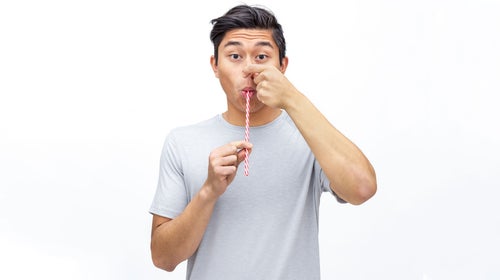“Begin by gathering up all your attention and bringing it to whatever sensations you’re feeling in the body.”
I’m lying on the rug in my living room, listening to Pete Kirchmer—a professional life coach and the director of , a performance-driven mindfulness program—walk me through a “body-scan meditation” via an app on my phone. Kirchmer directs me to focus on each body part, starting with my feet and methodically moving up toward my head. After a few moments, I notice a tingling sensation in my toes. When I get to my lower back, I feel some tension and try to relax it. In my abdomen, I sense mild anxiety as I finish each exhale. And at my head? Drool. I fell asleep around the ten-minute mark.
The body scan is my first homework assignment in a nine-week mPEAK class. (The acronym stands for Mindful Performance Enhancement, Awareness, and Knowledge.) The program launched in 2014, when a group of neuroscientists and mindfulness experts from the University of California at San Diego joined forces with coaches from the USA BMX Cycling team to study a meditation-based curriculum for elite athletes. Over seven weeks, Olympic-level racers practiced mindfulness to increase interoceptive awareness—the sensations we feel in our bodies, whether stomach butterflies or shoulder tension. Afterward, according to a published study, the participants were better equipped to handle stress during races.
Research shows that meditation reduces stress, lowers blood pressure, boosts the immune system, increases our capacity to learn, and may even slow the aging process.
The athletes’ brains changed as well. Before and after the program, participants were given a test designed to induce stress—inhaling through a mouthpiece that restricts breathing—while lying in an fMRI machine. The results showed that the athletes had reduced connectivity between the posterior cingulate cortex (PCC), one of the regions in the brain responsible for self-awareness, and the anterior cingulate cortex (ACC), which plays a part in impulse control and decision-making. The upshot: when stressed, athletes generated less of the negative self-talk in the PCC that can lead to diminished results.
I was intrigued by the idea of a mindfulness class aimed at performance, but I’d already read plenty of headlines touting the benefits of sitting still in a dark room and focusing on breathing. Research shows that meditation reduces stress, lowers blood pressure, boosts the immune system, increases our capacity to learn, and may even slow the aging process. But many of these benefits accrue only with consistent practice, something I’ve always had trouble with. So when I signed up for mPEAK, I wasn’t really looking for performance gains—I was trying to purchase accountability. I figured that paying $250 for nine classes spread over two months might be the kick start I needed to build an enduring, lifelong habit.
Every Monday night, I joined 11 students at a wellness center in Santa Fe, where our instructor, Kate Reynolds (who was trained by Kirchmer in San Diego), led us through a series of exercises. First we learned the body scan—and were told, to my relief, that falling asleep is common—followed by box breathing (holding each inhale, exhale, and pause between them for a count of four), walking meditation (essentially slow-motion pacing), movement meditation (akin to tai chi), and breath meditation (the familiar sitting practice). After each lesson, we’d talk about our experiences, learn about the goal of the technique we’d just been instructed on, and participate in various stress tests, including straw breathing (harder than it sounds) and squeezing a piece of ice for several minutes (surprisingly painful), using mindfulness tools to persevere.
I’m able to catch myself before getting lost in my usual thought patterns while driving to work, instead forcing myself to notice something new every day.
Between classes we were directed to maintain a daily meditation practice for whatever amount of time we were willing to commit to. (I started with ten minutes.) We were also given homework assignments intended to make us reflect on our experiences. One worksheet, ominously titled Unpleasant Events Calendar, asked us to record an irritating experience each day for a week, including the thoughts we had and the feelings in our body as the minor crises transpired. We did the same thing the following week for pleasant events. The lessons gently prodded us to relearn how to recognize and experience stress, happiness, and anxiety—in our bodies rather than our heads. Cultivating that skill, according to one of the class handouts, “may hold the key to greater well-being and optimal performance.”
I’ve been lousy with the worksheets, but as the weeks go by, I’m acing the practice. I’ve increased my daily sit to 20 minutes, and I’m noticing minor shifts in how I move through the world. I’m able to catch myself before getting lost in my usual thought patterns while driving to work, instead forcing myself to notice something new every day. I’ve started adapting the walking meditations to my daily runs, paying attention to minute bodily sensations—stress, fatigue, general wear and tear—rather than the from The New York Times. In fact, after last week’s lesson, I turned off the podcast altogether.
In class we learned how setting aside blocks of unstructured time to simply think can prime us for that elusive performance state known as flow. Running used to be where I did exactly that kind of free thinking—and it was my best source of creative ideas. It took mindfulness training to make me realize that I’d shut it all down with constant auditory stimulation. That insight alone was worth the $250. Next up: enlightenment.


